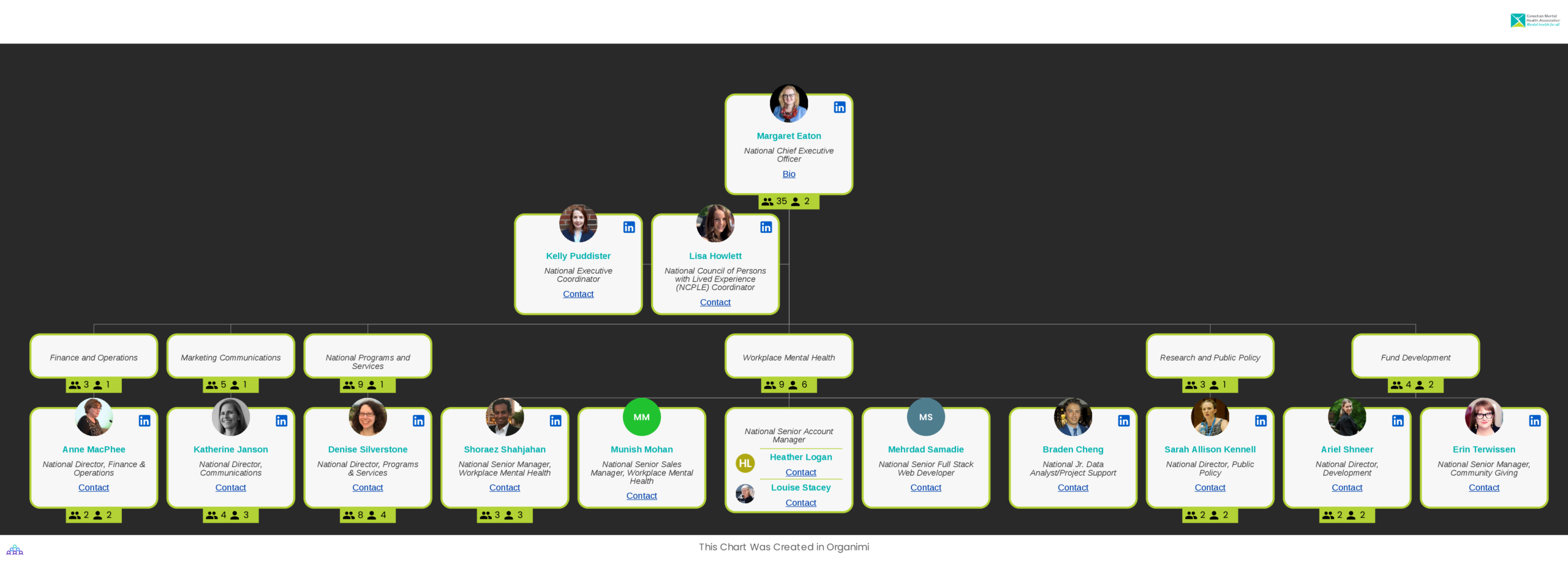Canadian Mental Health Association’s Organizational Structure
Create this exact chart in Organimi! Scroll below to see how.
Introduction
The Canadian Mental Health Association (CMHA) is a nationwide voluntary organization that promotes mental health and provides support to people who are recovering from mental illness.
The CMHA provides its programs and resources in over 330 communities across all of Canada’s provinces and one territory with the core goal of helping all Canadians prevent illnesses, build resilience, and flourish and thrive.
The CMHA is the only national organization that’s dedicated to the full spectrum of mental health and illness, and its work to address mental health priorities covers mental health promotion, suicide prevention, youth mental health, peer support, addictions and eating disorders, campus mental health, community research, first responders and Veterans.
Early History of the Canadian Mental Health Association
Founded in April 1918 as the Canadian National Committee for Mental Hygiene (CNCMH), the voluntary organization was founded in response to the hundreds of soldiers returning home from World War I with serious mental illness. Many returning veterans were placed into prisons and asylums, and as the founder of the then-CNCMH noted, the lack of support and treatment offered to these veterans required change.
Many prominent physicians, educators, and officials joined the CNCMH’s first Board of Directors, including Dr. C.F. Martin, Professor of Medicine at McGill University; Sir Vincent Meredith, President, Bank of Montreal; and Montreal financier and philanthropist, Richard B. Angus.
Initial surveys conducted by the CNCMH exposed the extent of mental disorders in Canada and found that they extended well beyond veterans into areas like schools. In response, the CNCMH recommended that the government spend over CAD$6 million to improve facilities and provide special education for children with mental health problems.
As a result, 150 special education classes were established, rehabilitation of soldiers suffering from mental health issues was properly addressed, and a sharp reduction in new mental health cases was witnessed throughout the country.
The CNCMH Becomes the CMHA
Throughout the years, the CNCMH continued to grow its influence and impact. It was particularly influential in changing government policy and the nation’s attitude towards people suffering from mental health problems.
In 1937, pressure from the CNCMH led to Alberta enacting a new law — “An Act Respecting Mentally Incompetent Persons and their Estates” — and in 1949, the CNCMH oversaw the replacement of the “Estates of the Mentally Incompetent Act” with the “Mentally Incapacitated Persons Act” in Alberta.
In 1950, the Canadian National Committee on Mental Hygiene was renamed and became the Canadian Mental Health Association. Over the years, several new projects were introduced which now form the backbone of the CMHA. These include:
-
Peer Support Canada
-
Workplace Mental Health
-
Canada Suicide Prevention Service
-
‘BounceBack’
-
‘Not Myself Today’
-
‘Carryit’
To date, the CMHA is credited with initiating programs, services, conferences, and resources in 294 communities, youth services and support in 216 communities, and suicide prevention initiatives in 201 communities.
Canadian Mental Health Association’s Organizational Structure & Leadership
Although the CMHA is a voluntary organization, the sheer size and scale of its operations mean that it is led by a full-time team of senior leaders who are responsible for managing the organization and ensuring it realizes its goals.
Here’s a look at the CMHA’s current organizational structure which highlights key people and the roles they play:

The CMHA’s senior leadership team, led by National CEO Margaret Eadon, includes roles you would expect to find at any other organization: marketing, finance, and general operations. The directors of the charity’s national programs and services such as Peer Support Canada and the Canadian Suicide Prevention Service also feature here.
The CMHA’s senior leadership team is supported by a Board of Directors who are both elected and appointed and have real-world experience and expertise in the mental health field.
As is typical in an operation of this size, the organization is split up into different groups according to their function.
Finance and Operations, for example, has one National Director (Anna MacPhee) who is responsible for overseeing Finance and Human Resources, both of which have their own national coordinators (Farhan Ali and Zehra Mirza respectively).
National Programs and Services, which is a much larger functional group, is led by the National Director for Programs & Services (Denise Silverstone) who is responsible for overseeing the day-to-day operation of the charity’s many flagship programs. She has several functional managers reporting to her as a result.
Learn more about organizational charts:
If you want to learn more about org structures and the huge role that they play in organizations like CMHA, here are some resources that you can start with:
Create this chart in Organimi!
You can download the CSV file of Canadian Mental Health Association’s org structure, import it into Organimi and start editing this chart right away! Here’s how:
- From your dashboard, select Data Import.
- Click the CSV tile.
- Click +Upload Your File.
- Select an Excel file from your device.
- In the Organization field, click the down arrow to select an organization.
- Click Create a New Chart
- Click Next and select: Organization Chart
- Select the auto-build tool to automatically build your chart.
- Voila!
Download CSV file: Canadian-Mental-Health-Association (10.91 KB)
Canadian-Mental-Health-Association (10.91 KB)
Build better org charts with
Organimi.
A powerful, cloud-based platform that helps you create, connect, and collaborate with your colleagues wherever they work.

